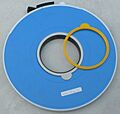Write protection facts for kids
Write protection is a clever way to stop information (called data) from being changed, deleted, or added to on a device. Think of it like a lock that keeps your files safe. Many games, music, and movies you buy already have write protection to keep them original and prevent accidental changes. This helps protect important data from being accidentally erased or attacked by computer viruses.
Contents
How Write Protection Works
Write protection usually works using a small physical part on the device itself. If you try to change something on a write-protected device, the hardware (the physical parts of the computer or device) will often stop you and send an error message. For example, some old tape recorders would even physically lock the record button if a tape was write-protected!
These protections are mostly for stopping accidental changes. If someone really wants to get around them, they often can. This might involve covering a notch with tape or even changing the device itself.
Examples of Write Protection
Many different types of storage devices have used write protection over the years:
- IBM Tape Reels: Back in the 1950s, large IBM tape reels had a special groove. To write new information onto the tape, you had to put a soft plastic ring into this groove. If the ring wasn't there, you couldn't write anything.
- Audio and VHS Cassettes: These tapes have small tabs on their edge. If you break off a tab, the cassette becomes write-protected, meaning you can't record over what's already there.
- Floppy Disks:
* Older 8-inch and 5.25-inch floppy disks had notches on their sides. Covering or punching a notch would protect the disk. Sometimes, people would punch a second notch on single-sided floppies to use both sides, creating a "flippy disk." * Smaller 3.5-inch floppy disks have a sliding tab in a window. If the window is open, the disk is protected.
- Iomega Zip Disks: These disks used special software called IomegaWare to turn write protection on or off.
- Syquest EZ-drive Disks: These had a small metal switch on the back of the disk to protect them.
- Video Cassettes (VHS-C, Video8, Hi8, DV): Like audio cassettes, these video tapes have a sliding tab on their back edge for protection.
- Iomega Ditto Tape Cartridges: These had a small sliding tab on the front.
- USB Flash Drives: Some older USB drives had a small switch to turn write protection on or off, like the Transcend JetFlash series. This is less common now.
- Secure Digital (SD) Cards: Many SD cards, used in cameras and phones, have a small sliding tab on their left side. If the tab is slid down, the card is write-protected.
- Read-Only Media: Some media are designed to be write-protected forever. Once information is put on them, it can never be changed. Examples include CD-R (CD-Recordable) discs, DVD-R (DVD-Recordable) discs, and old vinyl records.
Write Blocking
Write blocking is a special type of write protection used in computer forensics. This is when experts investigate computers to find evidence. Write blocking makes sure that nothing on a storage device, like a hard drive, can be changed while they are looking at it. This keeps the original information safe and proves that it hasn't been tampered with.
Both hardware (physical devices) and software (computer programs) can be used for write blocking. However, hardware write blocking is usually more reliable because it's harder for people to make mistakes with it.
See also
 In Spanish: Protección contra escritura para niños
In Spanish: Protección contra escritura para niños
- Copyright infringement
- Bootleg recording
Images for kids




